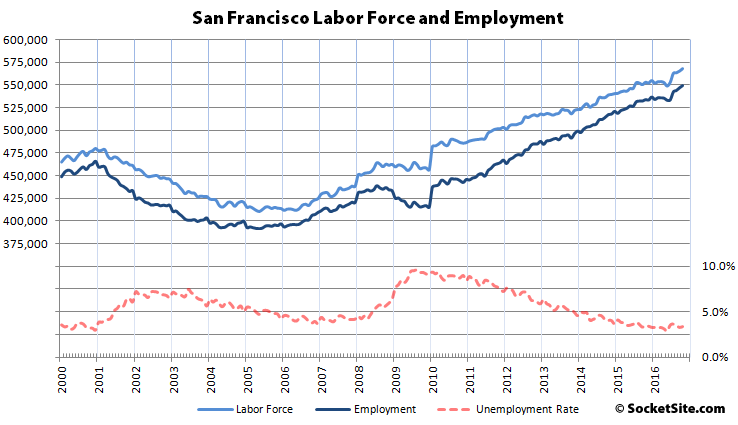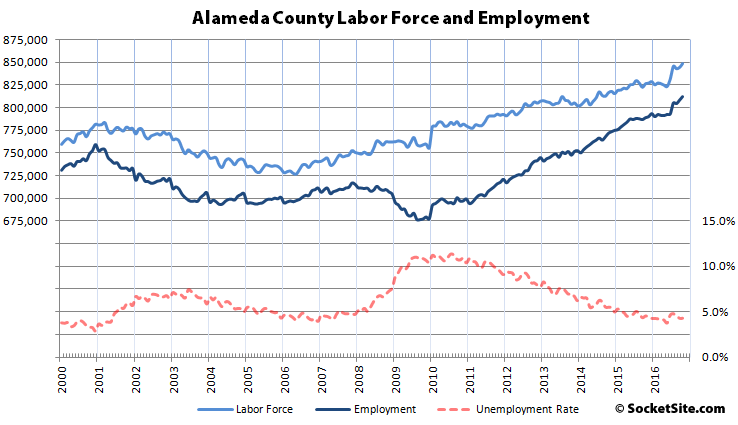While the unemployment rate in San Francisco ticked up from 3.3 percent in September to 3.4 percent last month, it was driven by an increase in the size of the labor force and the number of people living in the city with a job increased by 2,400 to a record 548,900.
As such, there are now 83,400 more people living in San Francisco with paychecks than there were at the end of 2000, an increase of 112,200 since January of 2010 and 15,400 more than at the same time last year.
In Alameda County, which includes Oakland, while the unemployment rate held steady at 4.3 percent, employment ticked up by another 3,900 in October to a record 812,100, which is 23,200 higher than at the same time last year and an increase of 120,100 since January 2010.
And while the unemployment rate across the greater East Bay held at 4.4 percent, employment ticked up by 6,500 to a record 1,352,000.
Up north, employment in Marin County ticked up by 1,300 to a record 141,700 while the unemployment rate held at 3.3 percent. And down in the valley, while the unemployment rate in San Mateo County ticked up from 3.0 to 3.1 percent, employment increased by 2,000 to a record 443,600 and by 2,500 to a record 1,018,300 in Santa Clara County while its unemployment rate held at 3.8 percent.


Interesting stat – BART ridership this summer dipped slightly, for the first time in about four years.
Lots of funding money these days is going into large existing companies and/or late round, not brand new startups.
Increased adoption of Uberpool and Lyft Line definitely plays a part in that slight decrease. As most of decrease is in weekend ridership rather than weekday.
Saddie, thanks for the continued comedy that is your business commentary. This time, your comment is again meaningless, because large (and midsize, like the 10 to 50 employee companies of many people I know) have the bulk of tech employees in the region. So if BART ridership is down, you seem to be alleging that jobs are down. Yet they are not. I.e., you are drawing a connection between two things that have an unlikely relationship (not a first for you.)
But please, tell us how all the companies are fake, because you understand tech. And give us more of those comparisons to companies of the 1970s. And tell us how underpaid today’s tech employees are, and how few of them can come up with 200 to 400k downpayments and afford to pay 900 to 1.8m mortgages…..that these aren’t the bulk of today’s buyers.
No I am not alleging jobs are down, employment is clearly up per the chart, but it does not differentiate between tech jobs and all other types of jobs. And I don’t need to understand tech, the industry doesn’t matter, it’s the money that matters.
Interesting what a relatively small impact the “Great Recession” (2008-10) had on SF compared to the huge impact the “Dotcom Implosion” (2000-5) had. Alameda Cty , OTOH, seemed to have been impacted more in line with the rest of the country (though probably more impacted by Dotcom and less by Greater than other areas) None of this is unexpected of course – it conforms well to the stereotype of the Bay Area being in its own world – but the magnitude is remarkable.
that is very true. Tech 2.0 blunted the great recession enormously in SF.